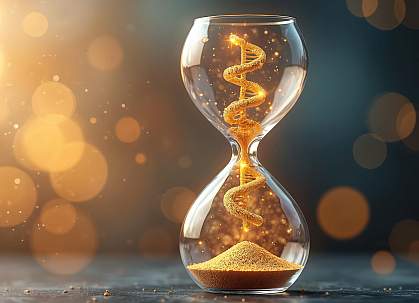You are here
May 20, 2025
Gauging biological age to predict future health
At a Glance
- Researchers developed a tool to quantify a person’s biological age and health status.
- If the new measures can accurately predict future disability and mortality, they could help to guide lifestyle changes that improve health.

Age and health are clearly connected, with the risk for many diseases and health conditions rising with age. Yet people of the same age can show vast differences in overall health. Some have multiple chronic conditions affecting various parts of the body by midlife, while others have a clean bill of health into their 70s and beyond. One theory holds that such differences stem from variation in biological aging. This is the extent of damage that builds up across tissues and organs, leading to chronic conditions, physical decline, and disability.
Existing measures of biological age, such as the Frailty Index, try to capture a person’s health based on the number of health deficits they have. But these approaches don’t fully capture the complexity of biological aging. A research team led by Drs. Shabnam Salimi and Daniel Raftery at the University of Washington School of Medicine and Drs. Luigi Ferrucci and Marcel Salive at NIH’s National Institute on Aging wanted to develop a way to better capture a person’s health and rate of biological aging. The method they developed, called the Health Octo Tool, is described in Nature Communications on May 5, 2025.
To develop the tool, the team turned to data from multiple long-term studies that included more than 40,000 people. First, the researchers defined disease states and their severity for each of 13 major organ systems based on accepted medical criteria. These systems included cardiovascular, kidney, metabolic, gastrointestinal and liver, respiratory, thyroid, blood, oral health, bones and muscles, sensory, and the central nervous system. The team also considered whether a person had a history of stroke or cancer.
The analysis of organ-specific disease was used to predict what the researchers call Bodily Organ-Specific Clocks. Then, by combining all the organ systems together, they created a measure, called the Body Clock, that captures a person’s overall health state without regard to chronological age.
The team found that the Body Clock accurately predicted a person’s performance on a short assessment used to gauge physical functioning including balance, walking speed, and strength. It also predicted disability and mortality with more than 90% accuracy. The Body Clock predicted health outcomes better than the Frailty Index.
The scientists went on to develop a collection of eight metrics that reflect different aspects of a person’s health and biological age. For example, they used the Bodily Organ-Specific Clocks and Body Clock to calculate a person’s overall biological body age. Two other measures consider how the Body Clock affects a person’s walking speed and their physical and cognitive disability.
Because these measures included early or pre-disease states, the Health Octo Tool could be used to track changing health and disease across a person’s lifespan. It may also identify those at risk for accelerated aging. The hope is that it will contribute to development of more effective lifestyle and healthcare strategies. Its use could suggest personalized interventions by identifying health declines early.
“An aging-based framework offers a new path to discover biomarkers and therapeutics that target organ-specific or whole-body aging, rather than individual diseases,” Salimi says.
—by Kendall K. Morgan, Ph.D.
Related Links
- Scientists Find Subtypes of Senescence
- Research in Context: Can We Slow Aging?
- Assessing Ways to Gauge Aging Status
- Tracking Organ Aging and Disease
- Blood Protein Signatures Change Across Lifespan
- Healthy Aging
References: Health octo tool matches personalized health with rate of aging. Salimi S, Vehtari A, Salive M, Kaeberlein M, Raftery D, Ferrucci L. Nat Commun. 2025 May 5;16(1):4007. Doi: 10.1038/s41467-025-58819-x. PMID: 40325006.
Funding: NIH’s National Institute on Aging (NIA).
